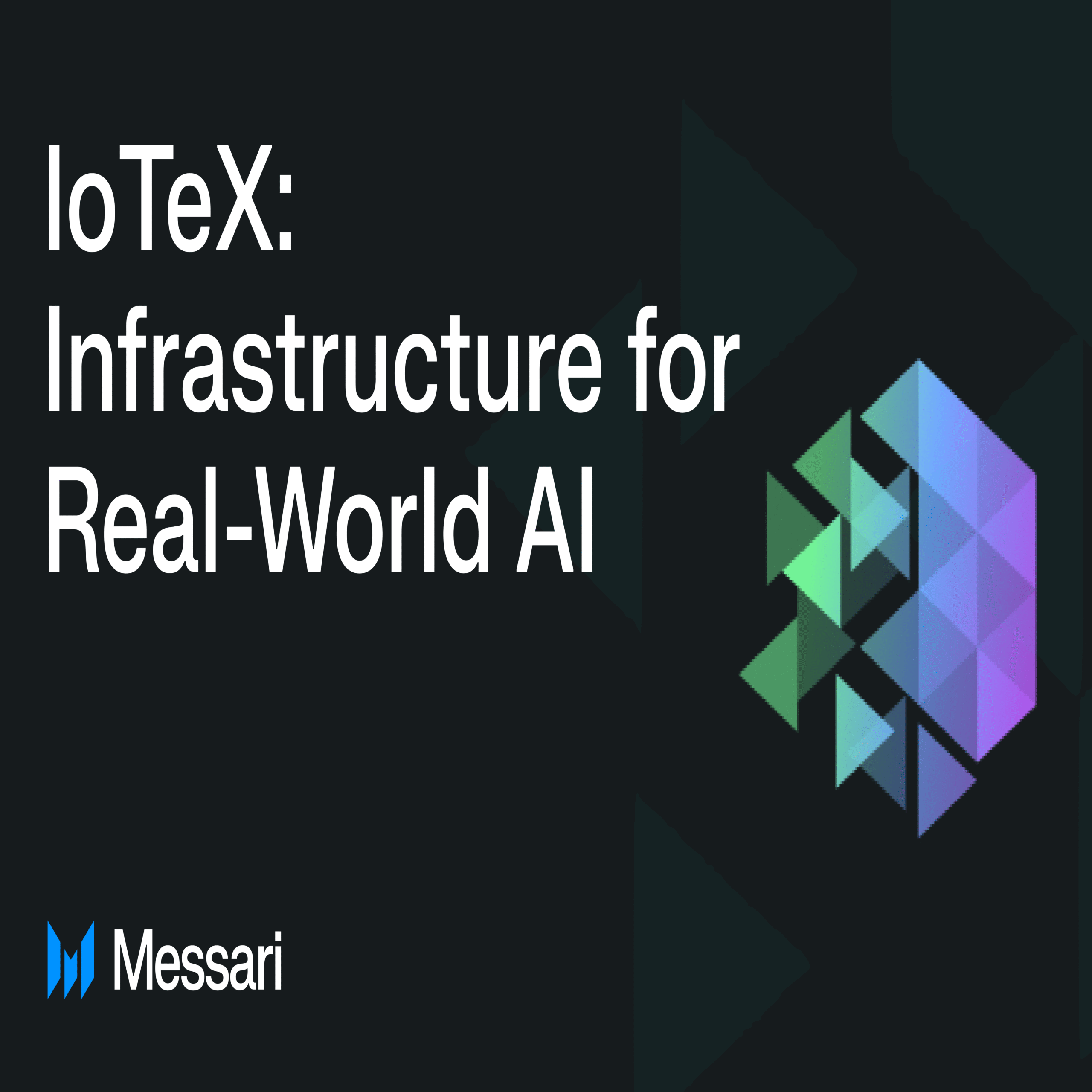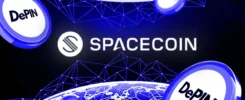Key Insights
- In July 2025, IoTeX announced a roadmap to build an AI infrastructure stack using DePIN data, with modules spanning its L1 (execution), W3bstream (offchain proofs), ioID (device and agent identity), Quicksilver (data aggregation), and Realms (domain-specific data augmented with human input).
- ioID device owners increased 1,697% YoY from 167 on Sept. 13, 2024, to 3,170 on Sept. 12, 2025. Registered devices increased 337% from 2,250 to 12,100 over the same period.
- Average daily Quicksilver requests increased by 291% MoM in August from 291 in July to 1,137.
- In July, IoTeX partnered with EV battery management company U Power to register battery-swapping stations onchain and telecom company Vodafone to register cell towers onchain to allocate excess computing power to AI training.
Primer
IoTeX (IOTX) is a modular infrastructure platform that supports 130 applications in a decentralized physical infrastructure network (DePIN) ecosystem, where connected devices supply verified data for AI applications and physical intelligence. The IoTeX network comprises an EVM-compatible Layer-1 (L1) blockchain, an offchain computing layer that generates validity proofs for data verification (W3bstream), an identity framework for smart devices and AI agents (ioID), and Quicksilver AI, which indexes data from connected devices, sensors, and Web2 data APIs. IoTeX supports integrations with data sequencer and availability applications, though none currently use its infrastructure. In July 2025, IoTeX added a new module called Realms, which are industry-specific datasets (augmented with human input) that group real-world data, AI agents, and contributors around domains such as road conditions, health statistics, or energy output.
Users stake IOTX, the IoTeX L1’s native token, to vote for community-elected delegates who secure the network, validate transactions, and produce new blocks. IOTX can also be used to pay gas fees on the IoTeX L1. The IoTeX L1 uses a Randomized Delegated Proof-of-Stake (Roll-DPoS) consensus mechanism, selecting 24 of the top 36 delegates every hour to secure the network.
BinoAI, IoTeX’s DePIN-focused AI agent built on Quicksilver, autonomously posts on X and the IoTeX community forum to share insights on DePIN and AI projects. For a full primer on IoTeX, refer to our Initiation of Coverage report.
Introduction: Real-World AI
Large language models (LLMs) train on static datasets from websites, books, and code repositories that remain fixed at training and quickly become outdated. AI systems need frequently updated, verifiable data from devices, sensors, and infrastructure to power real-world AI applications, but gaps in availability or quality can result in biased or unreliable outputs.
In July 2025, IoTeX released a roadmap to build an AI infrastructure stack based on physical intelligence that lets AI agents process verified DePIN data for context-aware applications (i.e., mobility, robotics, energy, or healthcare). IoTeX plans to place its stack at the center of a data loop where DePINs supply data, IoTeX verifies and contextualizes it, and AI agents consume the output. In the proposed roadmap, the IoTeX L1 blockchain will verify real-world signals onchain, ioID will authenticate the onchain identity of machines and agents, Quicksilver will validate incoming DePIN data and structure it into an AI-readable context, and AI agents built on Quicksilver will act on frequently updated feedback.
IoTeX is pursuing adoption from DePIN builders, application developers, and protocols that rely on authenticated machine data and sectors outside crypto, such as AI developers, manufacturers, and logistics providers.
On Aug. 26, Animoca Brands invested in IoTeX to support its real-world AI expansion in Asia and joined as a validator. The partnership aligns IoTeX with a leading blockchain investor, adding institutional backing to its initiative.
IoTeX Tech Stack
The IoTeX network uses a modular architecture that combines identity, data verification, agent execution, and contextual datasets. These functions are provided by ioID, W3bstream, Quicksilver, and Realms, respectively, and together, they form the foundation for IoTeX’s real-world AI initiative. The following sections describe how each module operates in the context of real-world AI applications.
ioID: Identity Layer
ioID is an onchain identity framework that authenticates smart devices, sensors, and agents. The core components of the ioID architecture are ioID identifiers, device NFTs, Machine-Bound Accounts (MBAs), and an ioID registry that links each device to its owner wallet and account. Device NFTs provide onchain representation and ownership, while MBAs let machines transact and interact with services without continuous human oversight.
Real-world AI depends on knowing who or what produced data. ioIDs link machine outputs to authenticated identities, allowing applications to consume data from verified devices. They also provide an ownership and permissioning path for machine owners’ wallets, which is necessary for automated actions, payments, or rewards tied to data provision and quality. In practice, a sensor registered with ioID can stream measurements, receive payments to its MBA, and record history across ownership changes, producing an audit trail for AI models.
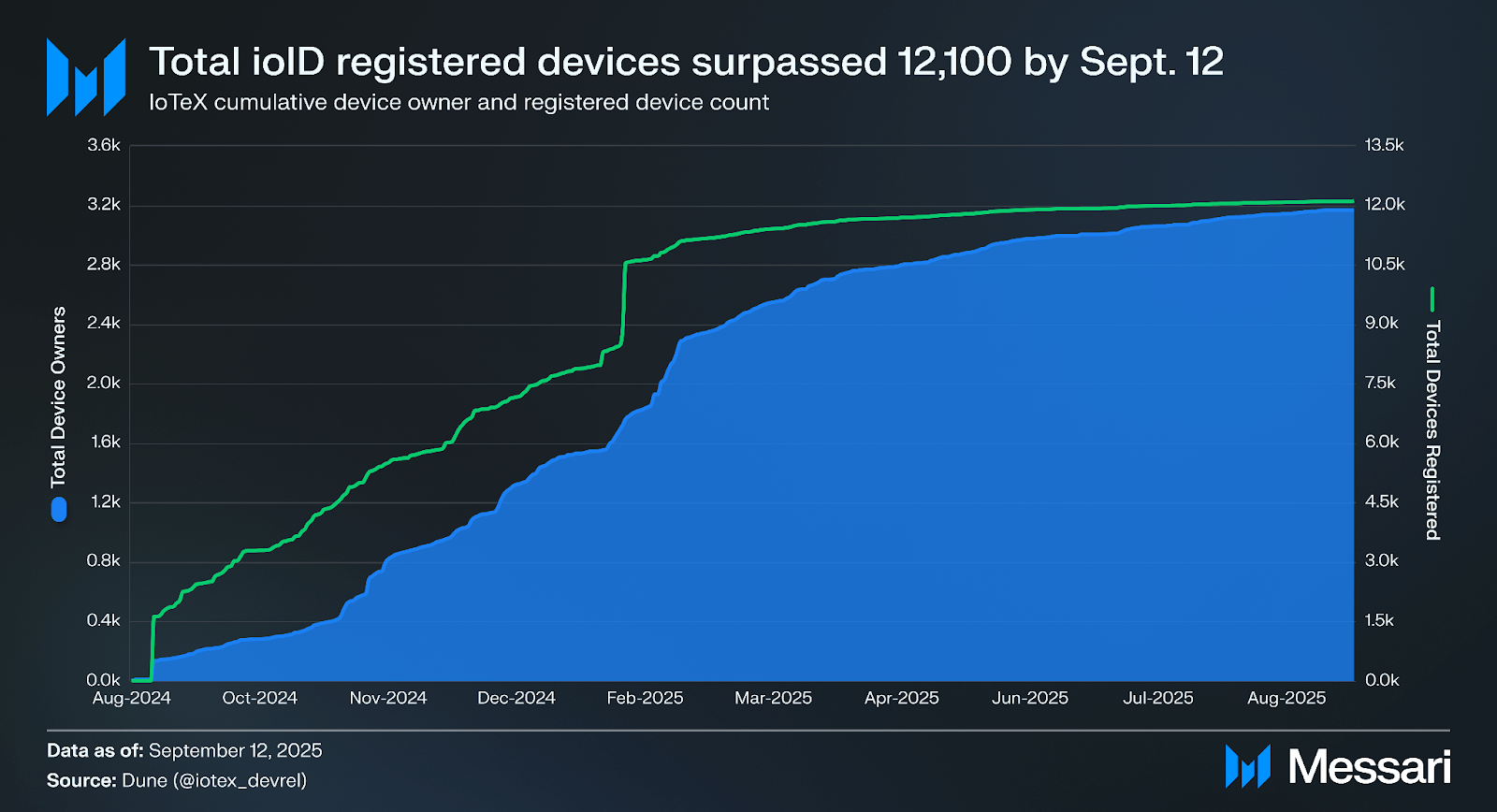
ioID device owners increased 1,697% YoY from 167 on Sept. 13, 2024, to 3,170 on Sept. 12, while new ioID devices registered increased 337% from 2,250 to 12,100 in the same time frame. The growth suggests rising demand for onchain DePIN device identification, with more owners and devices choosing ioID to verify their presence onchain.
W3bstream: Proof Layer
W3bstream is an offchain computing layer that uses zero-knowledge (ZK) proofs to verify DePIN device data and post validated proofs of real-world activity onchain. It sits between raw device output and data consumption layers, providing integrity checks that reduce the risk of real-world AI models and agents acting on fabricated or tampered data. Integrated with Quicksilver, W3bstream makes verified device data available for AI agents through a standardized interface, allowing developers to access trusted inputs without building bespoke pipelines for each source.
Quicksilver: Aggregation Layer
Quicksilver is a framework for aggregating and providing verified data from DePINs to AI agents, allowing them to query physical-world data, analyze it, and take automated actions. Developers use the open-source framework to build AI agents, set logic and API access, configure pricing, and let users query them through chat or API.
Users can interact with agents directly or through a global chat, where Quicksilver’s “core orchestrator” selects the most relevant agents and APIs for each query, and composes a response from their outputs.
Early examples include DePIN Agent, which answers blockchain-related questions using data from IoTeX protocols, and Weather Agent, which retrieves environmental data like temperature, humidity, and precipitation from providers including Nubila. Both remain in development.
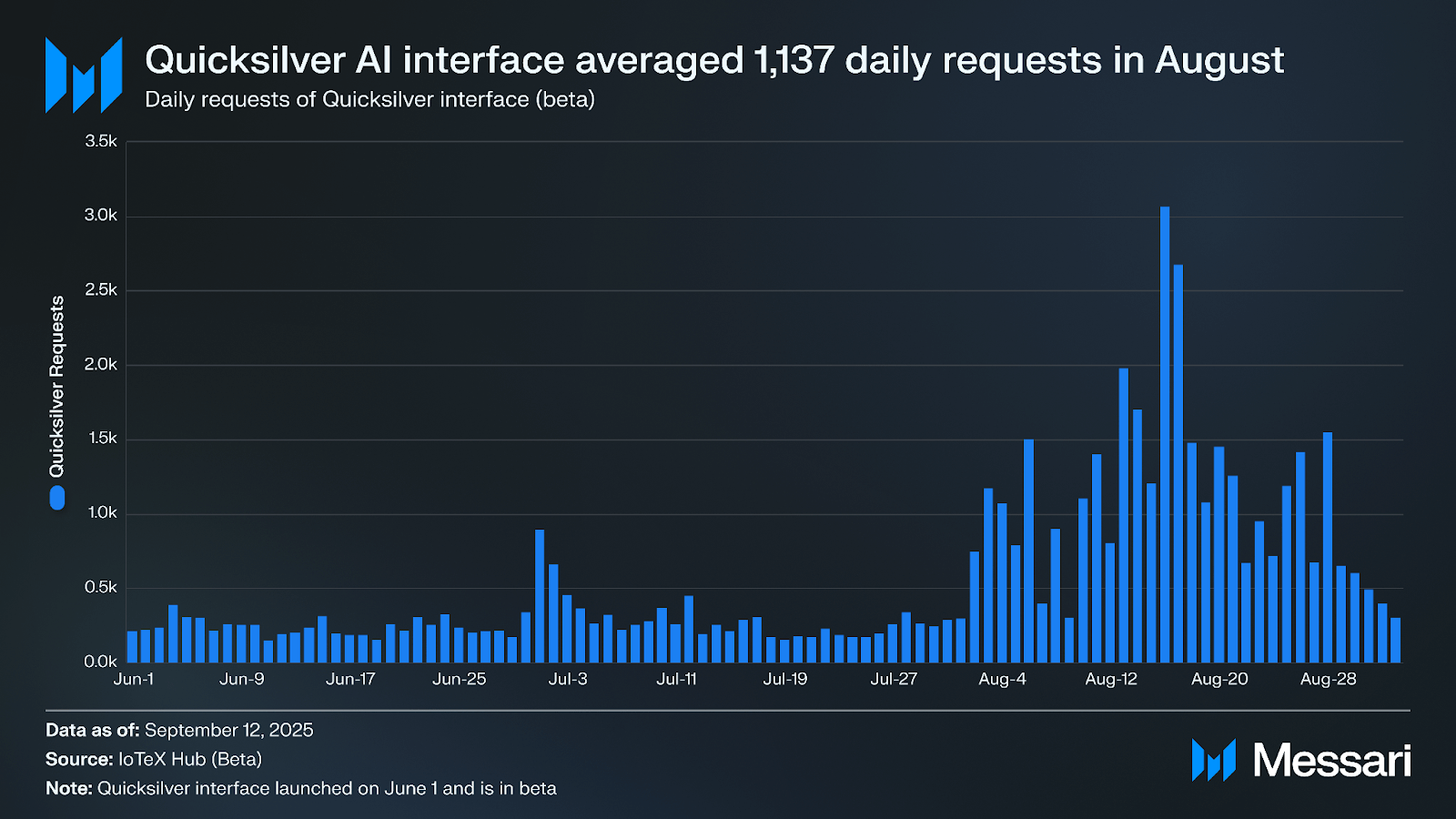
Average daily Quicksilver requests increased by 291% MoM from 291 in July to 1,137 in August. Quicksilver agents process user prompts using LLM integrations with OpenAI (GPT-4o-mini), Anthropic (Claude 3.5 Haiku), and DeepSeek. They pull data from APIs, blockchains, and DePIN networks, and execute actions such as sending transactions, posting to social platforms, or calling services. Demand for Quicksilver’s agent framework has risen, even though access remains limited to select users.
Realms: Contextual Domain Intelligence Layer
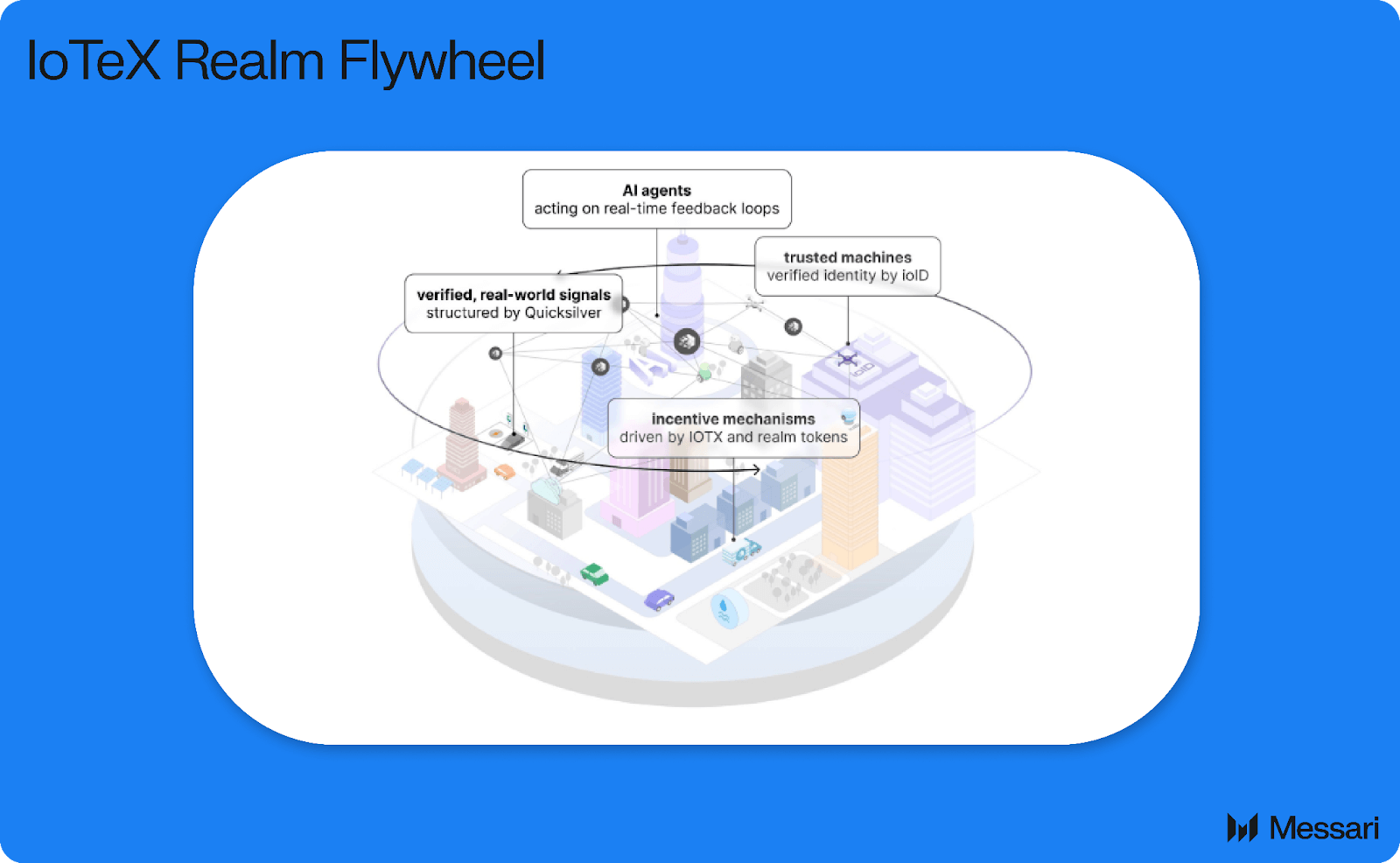
Source: IoTeX X post (July 15)
Realms organize data, agents, and contributors into sector-specific intelligence bases such as mobility, robotics, and energy. Contributors supply or label machine data, AI developers train domain-specific models, and applications pay to query the model APIs. The objective is to provide a structured, sector-aware context that improves agent reasoning and task execution.
For example, vehicles stream diagnostics, location, and traffic data in a transportation Realm. Quicksilver makes verified inputs available, while domain specialists tag variables such as vehicle type, time of day, and weather conditions, or simulate scenarios like congestion and incident response. AI developers leverage labeled data to train a transportation agent, which then uses these labeled, frequently updated datasets to query the resulting agent for routing, incident detection, and training autonomous systems.
Contributors earn rewards for supplying or labeling data in each Realm, and applications pay IOTX to query. Contributors include device owners and data labelers, creating feedback that raises dataset quality over time.
In July, IoTeX introduced an endpoint for cross-agent payments to exchange USDC for specialized data or tooling. The team demonstrated a live multi-agent collaboration in which Bino (a DePIN-knowledge agent) and Caila (a weather agent) exchanged 0.001 USDC microtransactions to fulfill out-of-realm requests. This payment primitive adds settlement to cross-agent cooperation and provides a mechanism that can support Realms’ contributor payouts and paid queries.
By combining authenticated device identities (ioID), verified data flows (W3bstream), agent execution (Quicksilver), and domain-specific intelligence with built-in payments, IoTeX plans to coordinate data supply and consumption for applications that rely on trusted, frequently updated machine data. As of Sept. 12, Realms remain in development.
IoTeX Layer-1: Settlement Layer
The IoTeX L1 blockchain is the settlement layer for authenticating identities, verifying proofs, and processing agent actions and payments. It also hosts the ioID registry and related contracts that anchor device and agent identities.
On June 19, IoTeX released the v2.2.0 hard fork, which reduced block time from five seconds to 2.5 seconds and increased theoretical throughput to 2,000 transactions per second to accommodate anticipated higher transaction volumes from latency-sensitive real-world AI applications. Community members recently proposed two IoTeX Improvement Proposals to slash underperforming delegates (IIP-50) and compress block signatures to improve block propagation efficiency (IIP-52), which are expected to further improve the security and scalability of the IoTeX L1.
Partnerships
In July 2025, IoTeX formed initial partnerships with EV battery management company U Power Ltd. and telecom company Vodafone, marking progress with companies with real-world AI demand.
U Power
On July 23, IoTeX announced a strategic partnership with EV battery management company U Power Ltd., whereby IoTeX agreed to purchase RWAs issued by U Power and backed by corporate bonds and U Power announced plans to accumulate IOTX as a strategic reserve asset reported under SEC requirements.
Founded in 2013 and headquartered in China, U Power operates primarily in China and Southeast Asia. Its flagship product is a battery swapping technology called the UOTTA system, which combines modular lithium-ion battery packs, automated swap stations, and management software to optimize charging time and battery degradation for EV fleets designed for use in dense urban environments such as taxis and delivery vehicles.
IoTeX will integrate its identity and data infrastructure into U Power’s battery-swapping network by registering each station onchain with an ioID and verifying data through Quicksilver to monitor performance, optimize energy distribution, and train AI systems for logistics and mobility. IoTeX plans to structure the stations into tokenized RWA products with capital flows tied to performance.
Vodafone
On July 2, Vodafone partnered with IoTeX, Coinbase, Chainlink, and others to register cell towers onchain and use their excess computing power to support AI inference and training. The initiative includes tokenizing cell towers, enabling institutional and retail investors to fund operations and receive payments tied to usage.
IoTeX provides infrastructure to authenticate towers, verify performance data, and structure them as tokenized RWAs. The partnership establishes cell towers as verifiable contributors within IoTeX’s DePIN stack, supplying computing resources that IoTeX monitors, monetizes, and allocates to AI workloads.
Closing Summary
In July 2025, IoTeX introduced a new roadmap to build an open AI infrastructure powered by real-world, frequently updated data. In the roadmap, IoTeX outlined its stack as a data loop where DePINs supply signals, IoTeX verifies and contextualizes them, and agents consume structured outputs. The stack includes an EVM L1, W3bstream for offchain data proofs, ioID for device and agent identity, Quicksilver for aggregating DePIN data and powering agents, and Realms, which organizes domain-specific intelligence for context-aware applications.
IoID device owners increased 1,697% YoY from 167 on Sept. 13, 2024, to 3,170 on Sept. 12, 2025, while registered devices rose 337% from 2,250 to 12,100. Average daily Quicksilver requests increased by 291% MoM from 291 in July to 1,137 in August. In July, IoTeX partnered with U Power and Vodafone to focus on adding authenticated infrastructure onchain and tokenized assets. IoTeX’s roadmap and partnerships position the network to expand its role in AI and DePIN by enabling builders that require verified machine data and AI agents that depend on authenticated, context-rich inputs.
Let us know what you loved about the report, what may be missing, or share any other feedback by filling out this short form. All responses are subject to our Privacy Policy and Terms of Service.
This report was commissioned by MachineFi, Inc. All content was produced independently by the author(s) and does not necessarily reflect the opinions of Messari, Inc. or the organization that requested the report. The commissioning organization may have input on the content of the report, but Messari maintains editorial control over the final report to retain data accuracy and objectivity. Author(s) may hold cryptocurrencies named in this report. This report is meant for informational purposes only. It is not meant to serve as investment advice. You should conduct your own research and consult an independent financial, tax, or legal advisor before making any investment decisions. Past performance of any asset is not indicative of future results. Please see our Terms of Service for more information.
No part of this report may be (a) copied, photocopied, duplicated in any form by any means or (b) redistributed without the prior written consent of Messari®.
